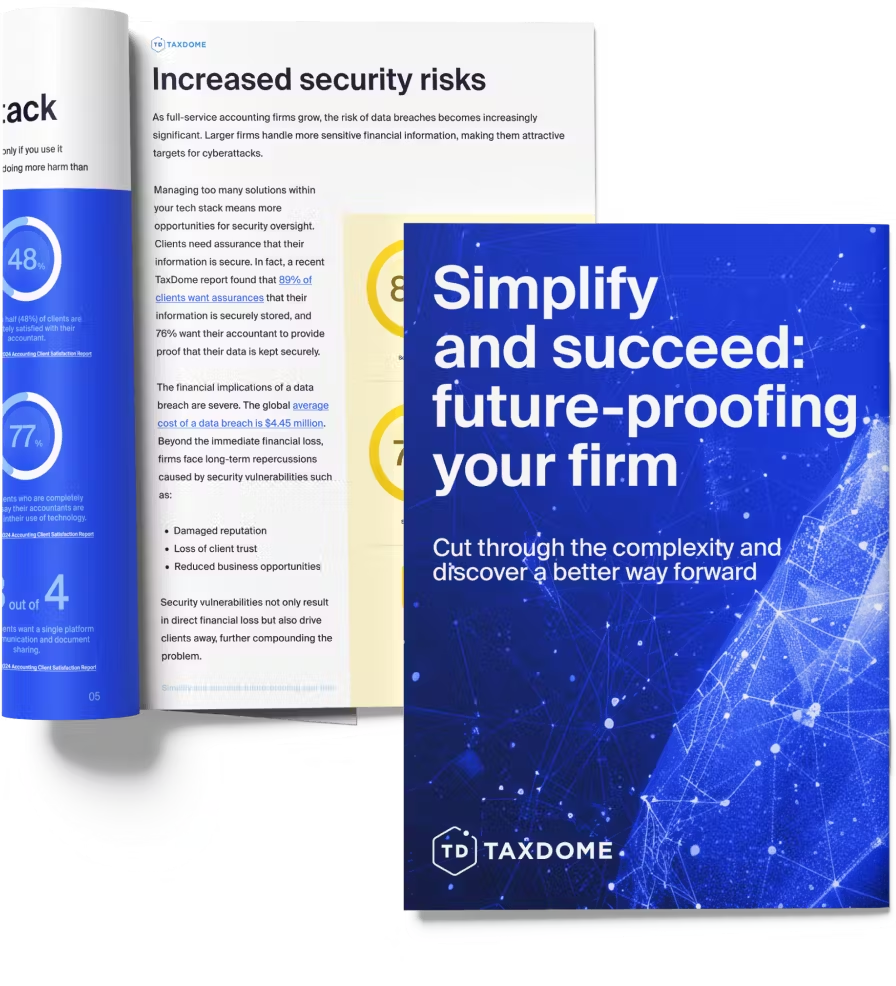
Each change requires a slight change of perspective, however, which can be dizzying for firms simply trying to keep up.
Technology has provided accounting firms with a wealth of new opportunities to impress customers, automate repetitive tasks, and save money.
That’s why we collected four of the most overlooked accounting practice management tips. Read on for expert tips on how to effectively manage your accounting practice through investments in cybersecurity, automation, accounts receivable, and client onboarding.
1. Most cybersecurity breaches come from within. Limit access to taxpayer data to a need-to-know basis.
Increasing worldwide cybersecurity risks have placed a great deal of pressure on accountancy firms to protect taxpayer data.
This pressure doesn’t just come from IRS regulation, as computer security is a growing concern among American consumers as well. In a recent RSA survey, 91 percent of respondents indicated that they want service providers make security more visible.
This security-forward culture provides an opportunity for today’s firms to earn client confidence.
But for security efforts to be successful, they must be tailored towards likely threats. Cybersecurity experts and research have shown that most breaches come from sources within the breached organization. That’s not to say employees are particularly untrustworthy, as human error is considered the most frequent origin of data security issues, according to Computer Weekly, 84 percent of cyberattacks are due to human error.
Regardless of who or what is to blame, mitigating internal risk is a crucial step in ensuring security.
We recommend firms limit employee access to sensitive data—only share such data on a need-to-know basis. If you’re working with contractors, don’t expose them to company-wide data collections. Instead, assign them clients to manage, or direct them towards accomplishing specific tasks that don’t require access to sensitive data.
The IRS recommends the following security practices:
- Tax documents should be software locked when sent to clients
- Email communication should be encrypted
- Passwords need changing every 60 to 90 days
- Complete a breach notification plan
For a complete walkthrough of accounting security recommendations, the IRS provides a thorough guide to protect taxpayer data.
2. The problem with relying on traditional email clients: inefficiency.
While the introduction of email has helped businesses improve communications and overall efficiency, advances since then have shown that relying on a single email client to handle all business communications is far from efficient.
Today’s marketers, for instance, increasingly use email marketing and accounting automation tools to reach customers at a scale much larger than outlook would otherwise allow. What’s more, accounting automation software stores data in a centralized, secure location, rather than data being spread out across dozens of team members, each within their own splintered, potentially vulnerable, inbox.
Firms stand to benefit greatly from accounting workflow automation software. And the benefits go beyond more efficient workflows.
CPA practice management software is built to serve both accountants and clients, with client portals that show outstanding bills, store uploaded tax documents and old returns, and allow for direct messaging between you and your clients.
By consolidating nearly all interactions on one platform, clients also get a sleek, unified experience. One that not only provides the tools and information they need–when they want it–but also demonstrates authority while conveying a positive brand experience.
3. Make payments flexible to recoup more from your accounts. And give them an incentive to pay up.
Accountants understand that clients are often unreliable in their communication. Some can be counted on to respond to inquiries quickly, meet deadlines, and pay in full, on time. Others, meanwhile, require a great deal more legwork, if they pay at all.
For those currently struggling with aging accounts and an aggravatingly high accounts receivable turnover ratio, we recommend accepting a greater variety of payment methods, like credit cards and automated clearing house payments (ACH) payments.
Recover aging accounts by giving clients more reasons to pay their outstanding invoices. With TaxDome, you also have the option to lock documents to bills, ensuring that you get paid for work you’ve completed.
4. Make the most out of new client onboarding.
Sometimes associated with the more tedious aspects of accounting work, new client onboarding represents a huge opportunity for firms looking to establish a positive relationship.
Knowledge is power, and in this case, asking the right questions allows you to set expectations positively, assure them of any fears, and remind them why they made the right choice in hiring you. To do so, be sure to cover the following topics:
- Their overall tax and financial goals
- Their overall experience and feelings on working with accounting firms
- Why they reached out to your firm
- The rest of the steps they’ll be taking in onboarding
- Your firm’s security practices/technologies
- Your firm’s ability to grow your clients’ business
- Their assigned point-person, and their contact information
Additionally, you’ll want to touch on deadlines. Keeping them involved in the process early helps clients feel more ownership over their part in the process. On top of that, a steady cadence of reminder messages helps keep your practice on their mind.
You only have one chance to make a first impression, as the saying goes, so make sure you hit the nail on the head. And if you want to automate the entire process, you can do this utilizing TaxDome workflow automations.
Take the next step.
At the end of the day, clients want an easy, stress-free and profitable experience. You’ve likely already dedicated a great deal of time to serve them better, and more efficiently, which makes continued refinement the next logical step in growing a competitive accounting practice.
TaxDome offers flexible and intuitive online practice management software for accountants, featuring a CPA client portal, customer relationship management (CRM), and world-class security, among many other options.

Thank you! The eBook has been sent to your email. Enjoy your copy.
There was an error processing your request. Please try again later.
What makes the best accounting firms thrive while others struggle to keep up? We analyzed our top 20 TaxDome firms, representing over $100M in combined revenue, to uncover the strategies driving their success.



